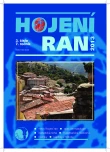Bee’s honey in the process of wound healing
Authors:
Juraj Majtán 1,2; Alexander Mayer 3; Miroslava Horniačková 2; Viktor Majtán 2; Juraj Olejník 3
Authors‘ workplace:
Ústav Zoológie SAV, Bratislava
1; Oddelenie mikrobiológie, Lekárska fakulta SZU, Bratislava
2; Chirurgická klinika SZU a FNsP, Nemocnica akad. L. Dérera, Bratislava
3
Published in:
Hojení ran 7, č. 3: 3-6, 2013
Category:
Bee’s honey in wound healing
Overview
Bee’s honey is a natural product with antibacterial and immunomodulating properties that fulfils the concept of an ideal tool in the process of healing of chronic wounds. The main advantage of the honey is its multifactorial antibacterial activity and the fact thatbacteria cannot develop a resistance to the honey. The honey and its individual components are able to both stimulate and inhibit the production of cytokines (TNF-α, IL-1β a IL-6) of monocytes and macrophages depending on the surrounding conditions as well as accelerate the process of re-epitelisation by a stimulation of the proliferation and migration of cutaneous cells (keratinocytes and fibroblasts).
Detailed characterization of biological effects of the honey will facilitate its wider use in clinics and greater concern in the community of medical specialists about the wound treatment with natural products.
Key words:
honey, wound healing, immunomodulation, antibacterial action
Sources
Biglari, B., Moghaddam, A., Santos, K. et al. Multicentre prospective observational study on professional wound care using honey (Medihoney™). Int Wound J 10, 3: 252–259, 2013.
Cooper, R. A., Molan, P. C., Harding, K. G. The sensitivity to honey of Gram-positive cocci of clinical significance isolated from wounds. J Appl Microbiol 93, 5: 857–863, 2002.
Fujiwara, S., Imai, J., Fujiwara, M. et al. A potent antibacterial protein in royal jelly. Purification and determination of the primary structure of royalisin. J Biol Chem 265, 19: 11333–11337, 1990.
Gannabathula, S., Skinner, M. A., Rosendale, D. et al. Arabinogalactan proteins contribute to the immunostimulatory properties of New Zealand honeys. Immunopharmacol Immunotoxicol 34, 4: 598–607, 2012.
Gethin, G., Cowman, S. Manuka honey vs. hydrogel - a prospective, open label, multicentre, randomised contolled trial to compare desloughing efficacy and healing outcomes in venous ulcers. J Clin Nurs 18, 3: 466-474, 2008.
Gottrup, F., Apelqvist, J., Price, P.; European Wound Management Association Patient Outcome Group. Outcomes in controlled and comparative studies on non-healing wounds: recommendations to improve the quality of evidence in wound management. J Wound Care 19, 6: 239–268, 2010.
Kwakman, P. H., te Velde, A. A., De Boer, L. et al. How honey kills bacteria. FASEB J 24, 7: 2576–2582, 2010.
Lin, S. M., Molan, P. C., Cursons, R. T. The in vitro susceptibility of Campylobacter spp. to the antibacterial effect of manuka honey. Eur J Clin Microbiol Infect Dis 28, 4: 339–344, 2009.
Lusby, P. E., Coombes, A. L., Wilkinson, J. M. Bactericidal, activity of different honeys against pathogenic bacteria. Arch Med Res 36, 5: 464–467, 2005.
Majtan, J., Kovácová, E., Bíliková, K., Simúth, J. The immunostimulatory effect of the recombinant apalbumin 1-major honeybee royal jelly protein-on TNFα release. Int Immunopharmacol 6, 2: 269–278, 2006.
Majtan, J., Kumar, P., Majtan, T. et al. Effect of honey and its major royal jelly protein 1 on cytokine and MMP-9 mRNA transcripts in human keratinocytes. Exp Dermatol 19, 8: e73–e79, 2010.
Mavric, E., Wittmann, S., Barth, G., Henle, T. Identification and quantification of methylglyoxal as the dominant antibacterial constituent of Manuka (Leptospermum scoparium) honeys from New Zealand. Mol Nutr Food Res 52, 4: 483–489, 2008.
Ranzato, E., Martinotti, S., Burlando, B. Epithelial mesenchymal transition traits in honey-driven keratinocyte wound healing: Comparison among different honeys. Wound Repair Regen 20, 5: 778–785, 2012.
Robson, V., Dodd, S., Thomas, S. Standardized antibacterial honey (Medihoney) with standard therapy in wound care: randomized clinical trial. J Adv Nurs 65, 3: 565–575, 2009.
Robson, V., Yorke, J., Sen, R. A. et al. Randomised controlled feasibility trial on the use of medical grade honey following microvascular free tissue transfer to reduce the incidence of wound infection. Br J Oral Maxillofac Surg 50, 4: 321–327, 2012.
Simon, A., Traynor, K., Santos, K. et al. Medical honey for wound care – still the ´latest resort´? Evid Based Complement Alternat Med 6, 2: 165–173, 2009.
Tonks, A. J., Cooper, R. A, Jones, K. P. et al. Honey stimulates inflammatory cytokine production from monocytes. Cytokine 21, 5: 242–247, 2003.
Tonks, A. J., Dudley, E., Porter, N. G. et al. A 5.8-kDa component of manuka honey stimulates immune cells via TLR4. J Leukoc Biol 82, 5: 1147–1155, 2007.
Labels
Surgery Nurse Home nurseArticle was published in
Wound Healing

2013 Issue 3
Most read in this issue
- The options of the use of the super-absorptive drain in the diabetic foot
- The use of the under pressure therapy in the vascular surgery – a case report
- Bee’s honey in the process of wound healing
- The curiosities from the history of health care transportation II.
